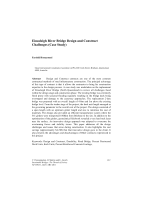Bridges

- Publication no: ABC-DES021-11
- Published: 31 October 2011
- PDF (free) Download
Design and Construct contracts are one of the most common contractual methods of road infrastructure construction. The principal advantage of this type of contract is that it allows the contractor to bring his construction expertise to the design process. A case study was undertaken on the replacement of Einasleigh River Bridge (North Queensland) to review all challenges faced within the design stage and construction phase. The existing bridge was extremely flood prone with seasonal flooding regularly resulting in the bridge deck being overtopped and damage to the causeway approaches.
The replacement 2-lane bridge was proposed with an overall length of 416m and 5m above the existing bridge level. From the tender stage of the project, the deck unit length emerged as the governing parameter in the overall cost of the project. The design consisted of a span length with an optimum girder length and size to minimise the cost of materials. The design also provided an efficient transportation system where the 561 girders were transported 1800km from Brisbane to the site. In addition to the optimisation of the girders, geotechnical fieldwork revealed a very hard rock layer near the surface.
An innovative design approach was adopted to overcome the overturning forces and stability issues. This paper addresses all the design challenges and issues that arose during construction. It also highlights the cost savings (approximately $4-5M) that that innovative design gave to the client. It also presents the advantages and disadvantages of D&C contracts experienced in this project.
